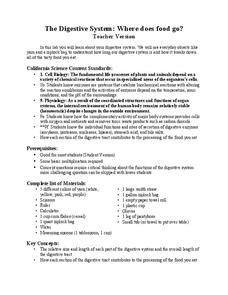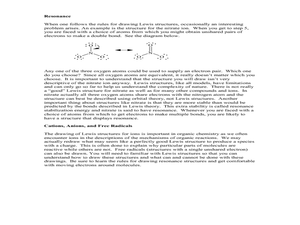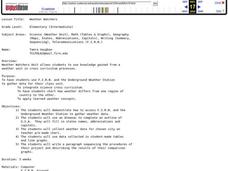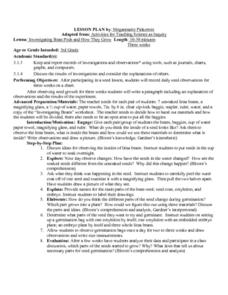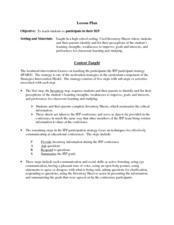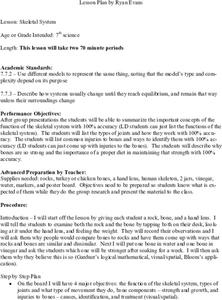LABScI
The Digestive System: Where Does Food Go?
Would you believe that your digestive system stretches to five times your height?! Help your pupils to understand this relationship as they work through the laboratory exercise. The first instructional activity of a 12-part series is a...
Cornell University
Fibers, Dyes, and the Environment
Nanofibers can be made through electrospinning or force spinning in order to reduce the negative impact on the environment. Pupils study the role of fibers and dye on the environment through a series of five hands-on activities. Then,...
Curated OER
Let's Get it Together! Reading to Learn
Let’s learn about frogs! Young readers are led through “Freaky Frogs,” a non-fiction article. Teach learners how to edit an article so there are fewer details to sift through. After talking through the article, they learn the six steps...
Curated OER
Drawing Lewis Structures
In this drawing Lewis structures worksheet, students read about the 5 steps taken to draw Lewis structures for atoms and molecules. These include identifying the valence electrons, placing pairs of electrons between atoms to be bonded,...
Curated OER
Early Scientists' Contributions
Five scientists and their contributions to modern cell theory are listed, one person per slide. It concludes by having viewers answer recap questions. This simple presentation can be used on the first day of your unit on cells...
Curated OER
Meet One Picky Bird
Students complete a research project In this endangered species lesson plan, students use the "Think, Puzzle, Explore" method to learn about endangered species. Students research and write a report on the red-cockaded woodpecker.
Curated OER
Cellular Respiration stage 1: Glycolysis
Ten reactions involved with the process of glycolysis within cellular respiration are summarized here. The aerobic stages and anaerobic interactions leading to fermentation are detailed and wonderful diagrams to support the information...
Curated OER
Fresh Foods from Farm to Table
Are you a good egg? Learners begin a farm-to-table lesson by acting out verbs in groups to demonstrate the egg production process, and then research the steps using online resources. Several excellent videos are linked through the...
Curated OER
Risk Watch Reporters Use Electrical Safety Eyes: Prevention is the Key
Young scholars review three true electrical stories, research true dangers involved in electrical discharges, identify and work to eliminate electrical hazards in their homes, and create electrical safety message to share with peers.
Curated OER
Weather Watchers
Students are introduced to an Underground Weather Stations. In groups, they use the internet to research the weather in different parts of the United States locating each city. To end the lesson, they summarize the information they...
Curated OER
Investigating Bean Pods and How They Grow
Third graders observe and create a record of seed growth over time. After planting a seed, 3rd graders record their observations of the seed's growth over a three week period. Upon conclusion of the experiment, they write a paragraph...
Curated OER
A Model of the Rock Cycle
In this rock cycle worksheet, young scholars use different colored crayons to represent different types of rocks. They follow step by step procedures to model the rock cycle with the crayons. Students draw the rock cycle, show...
Curated OER
Genetics and Heredity: The Next Generation
Tenth graders work in teams to order events of DNA transcription and translation protein synthesis. In the second instructional activity, they put the steps of mitosis and meiosis in order using a concept map poster. They use modeling...
Curated OER
Flight of the Future/Space Flight
Students explore space science by viewing videos on YouTube. In this moon landing lesson, students view clips of Neil Armstrong taking his first step on the moon and discuss the space race between the U.S. and Russia. Students utilize...
Curated OER
Electron Microscope
In this microscope worksheet, students use an on line site to answer questions about how a Scanning Electron Microscope works. They also conduct a virtual microscope activity where they view ten specimens and identify what each is.
Curated OER
The Design Process
Students work together to construct a foundation of nine 3" x 5" index cards to support their 9" textbook off their desk. They summarize the steps used to solve the problem and discuss and compare their solutions. They then complete the...
Curated OER
Charlotte's Web Animal Research Projects
Students summarize information taken from the internet about animal character's from the story, "Charlotte's Web." Questions are created, answered, and entered into a book about the animal of their choice.
Curated OER
IEP
Students and parents fill out an inventory sheets where they identify and list their perceptions of the student's learning strengths, weaknessess to improve, goals and interests, and preferences for classroom learning and studying.
Curated OER
Animal Diaries
Launch this lesson plan with Doreen Cronin's Diary of a Worm! Discuss the format and content of a diary, and ask learners if they've ever kept a diary before. Then, after an introductory discussion, have learners choose an insect or...
Curated OER
A Research Project and Article For the Natural Inquirer
Get your class to use the scientific process to solve a scientific problem. They utilize the Natural Inquirer magazine to identify a research question which they write an introduction to and collect data to answer. They use graphs,...
NASA
Data Literacy Cube: Global Atmospheric Temperature Anomaly Data
Evaluate global temperature anomalies using real-world data from NASA! Climatologists analyze a data set using a literacy cube and differentiated question sheets. Team members evaluate global temperature anomaly data with basic...
Curated OER
Presenting Ecology through Rodent Control
Young scholars discuss and explore an ecological problem regarding rodent populations. In this investigative lesson students work in teams, research a problem and present their findings to the class.
Curated OER
DNA Race Track
Twelfth graders simulate a DNA fragment running through a gel electrophoresis in a class activity. Students work in teams as a DNA sample with each person on the team representing a fragment that moves through the gel at a specific speed.
Curated OER
Skeletal System
Seventh graders explore the functions of the skeletal system. They collaborate in small groups to determine the function of the skeletal system, the types of joints and movement, bone strength and growth, and bone injuries including...
